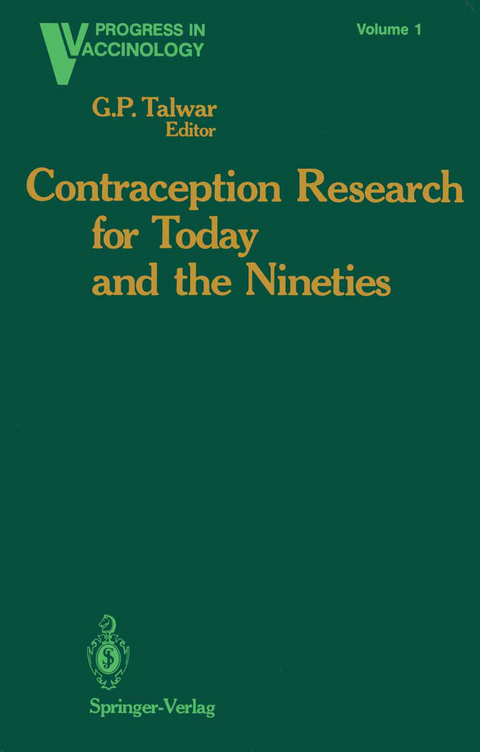
Contraception Research for Today and the Nineties
Springer-Verlag New York Inc.
978-1-4612-8331-7 (ISBN)
The twentieth century will close with 5 billion people added to the current global population. Between 1980 and the year 2000, the total world population will increase from 4 billion 10 a liUle over 6 billion. There will be half as many morc people on earth during these 20 years than the number accumulated since the origin of man to 1980. Overpopulation is particularly acute in economically developing countries, where contraception has become a social necessity. Comraceplion Researcll for Today and Ihe Nineties carries the proceedings of an international symposium convened in New Delhi in October, 1986, to review the status of current research in contraception. Major organizations supporting basic and applied research in contraception-The Population Council, World Health Organization (WHO), The Rockefeller Foundation, United States Agency for International Development (USAID), International Development Research Center of Canada (IDRC), National Institutes of Health (NIH), and the Indian Council of Medical Research (ICMR)- were represented by the heads of divi sions who projected respective programs and strategies. Principal scientists responsible for many of the new leads participated.
I Population Control and Development.- Demographic Trends, Global and Indian Scene, and Implications.- Population Control: Strategies and Experience.- WHO Special Programme in Human Reproduction and Contraceptive Needs of Developing Countries.- II Recently Developed Contraceptive Methods at Phase II/III/.- Steroid Implants for Long-Term Contraception.- The Levonorgestrei-Releasing IUD.- Antiprogestin Ru 486: A Contragestive Agent.- Vaginal Pills: Systemic Contraceptive Induced By Vaginal Administration Of Contraceptive Pills.- III Neuroendocrine Regulation.- Neuroendocrine Regulation of Fertility.- GnRH Analogs in Contraception.- A Novel Hypothalamic Peptide Inhibitor of Prolactin Secretion.- Inhibin: Chemistry, Measurement, Physiology, and Its Potential as a Fertility-Regulating Agent.- IV Immunobiology of Pregnancy.- Immunobiology of Human Trophoblast.- Maternal-Placental Interactions in Early Human Pregnancy.- Maternal-Blastocyst Interaction at Implantation.- Immunogenetic Control of Pregnancy and Development.- Cell-Mediated Immune Mechanisms in Recurrent Spontaneous Abortion.- V Birth Control Vaccines.- Birth Control Vaccines Inducing Antibodies Against Chorionic Gonadotropin.- Cloning and Expression of Gonadotropin Hormone Genes.- Hormonal Regulation of Pituitary Gonadotropin Gene Expression.- Active Immunization of Rhesus Monkeys Against the ?-Subunit of Ovine Luteinizing Hormone: Evaluation of Safety and Effectiveness of an Antigonadotropin Vaccine.- Safety Evaluation of HCG Vaccine in Primates: Autoantibody Production.- Potential of LH Receptor as an Immunocontraceptive Vaccine: Studies in the Baboon (Papio).- Development of a Contraceptive Vaccine for Use by the Human Male: Results of a Feasibility Study Carried Out in Adult Male Bonnet Monkeys (Macacaradiata).- VI Gamete Antigens for Birth Control Vaccines.- Hormonal and Cellular Control of Seminiferous Tubular Function.- LDH-C4 as the Model Sperm Antigen for a Contraceptive Vaccine.- Should Cell-Mediated Immunity be Considered in the Implementation of Antifertility Vaccines?.- Contraceptive Potential of Secretory Immunity.- Establishment of Human-Mouse Hybridoma to Human Seminal Plasma and Its Contribution to a Contraceptive Vaccine.- An Immunoreactive Human Sperm Antigen in Rate Spermatogenic Cells.- Role of the Fertilization Antigen (FA-1) in Immunoregulation of Fertility and Involuntary Infertility in Humans.- Origin of Zona Pellucida Antigens and Its Relevance to the Development of Contraceptive Vaccine.- Disillusions and Hopes About Zona Pellucida in Glycoproteins.- VII Basic Considerations in Immunological Approaches to Control of Fertility.- New Development in Epitope Analysis.- Immunological Difficulties and Requirements for Immune Manipulations in the Field of Reproduction.- The Past Is Prologue: Implications of the Symposium.
| Reihe/Serie | Progress in Vaccinology ; 1 |
|---|---|
| Zusatzinfo | XVII, 401 p. |
| Verlagsort | New York, NY |
| Sprache | englisch |
| Maße | 155 x 235 mm |
| Themenwelt | Medizin / Pharmazie ► Medizinische Fachgebiete ► Dermatologie |
| Studium ► Querschnittsbereiche ► Infektiologie / Immunologie | |
| Naturwissenschaften ► Biologie | |
| ISBN-10 | 1-4612-8331-0 / 1461283310 |
| ISBN-13 | 978-1-4612-8331-7 / 9781461283317 |
| Zustand | Neuware |
| Haben Sie eine Frage zum Produkt? |
aus dem Bereich


